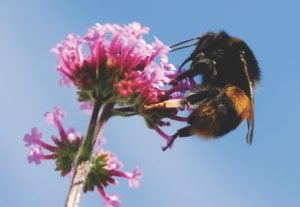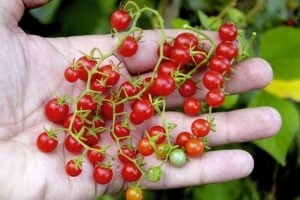Greenhouse tomato crops are bigger and better thanks to buzz pollination.
Don’t take your tomato crop for granted. Every single fruit that forms needs a pollinator catalyst.
The words Buzz and bees go hand in hand. But did you know that bumblebees perform something called Buzz Pollination that is vital for the way that they pollinate tomato plants.
Tomato flowers hold tightly to their precious pollen, making it hard to access for protein hunting insects. Pollinators feed on pollen and nectar, the pollen is rich in protein and generally fed to the developing larvae, the nectar is a high-energy sustenance food, collected and stored by honeybees and bumblebees as honey to sustain the colony.
When it comes to tomato flowers it’s the pollen that is the magnet for bees, but it’s the bumblebees that have learned how to harvest it efficiently. That’s good news for the plants as bumbles are furry and the odd pollen grain gets trapped on their fluff and transferred to neighbouring flowers as the bees hover between the blooms.
But it’s the way that bumbles get the pollen that is quite amazing. They use a technique called Buzz Pollination. They contract their flight muscles so that the power is diverted to their body, which vibrates not just their body but their legs and mouthparts too. When the bee is on the flower, this vibration loosens the pollen grains, which she then combs into her pollen baskets. Any grains that are missed are usually on the bee and then pollinate neighbouring flowers as she moves from flower to flower. It’s a technique that appears to be pretty unique to bumblebees and affords excellent pollination for crops within the Solanaceae family such as tomatoes, aubergines and potatoes (though we don’t eat potato fruits).
Bee access

In the greenhouse getting the balance right between allowing pollinators in and not trapping them in there is a fine art. The last thing you want to do is to allow access to queen bumblebees or hard working worker bees and then prevent them from returning to feed their babies, which would be a disaster. And yet these fascinating creatures are a vital pollinator of greenhouse tomatoes and other glasshouse crops. To such an extent that commercial growers buy in commercial bumblebee nests and keep them inside glasshouses and polytunnels for the season to ensure that the crop is pollinated and that the fruit harvest is generous. Sadly the nests and next years’ Queens are destroyed at the end of the season because most of the commercial nests are imported and could carry pests and disease that would spread to our native bees.
I try and keep my greenhouse in virtual lock down unless it’s very, very hot, so that pollinators don’t get trapped in there after sunset. But that means pollination can suffer. The auto vents are the only access area and I do get an occasional bumblebee flying in and then struggling to get out when the vents have closed as the greenhouse cools. A regular inspection allows me to catch them and let them free. But of course there are some days when I am away and can’t do the greenhouse bee check.
I’ve found the very best way to catch the little critters is with a spider vacuum. Yes really. It is battery powered and allows you to reach into the greenhouse eaves at a safe distance and vacuum them into a tube. (Spider Catcher)
It’s a very gentle vacuum and the bees (or spiders) are drawn to the bottom of the tube quite safely. Then they can be safely taken outside and released to fly back to their nest. It’s such a wonderful feeling to see them fly off.
Bee rescue
And for those exhausted bees there’s a surefire pick me up that will help them get back to their nest. A mimic of nectar, made from a strong sugar syrup (2:1 sugar to water), cooled, presented to the bee as a droplet that it can drink, is an almost instant rescue remedy for the little creatures. Don’t use honey, unless you are a beekeeper or know it has a good provenance. Let it drink and release it back into the garden to buzz another day.
Hand pollination

A lack of bumbles in the greenhouse can result in a dearth of tomatoes. But if necessary you can carefully hand pollinate the flowers by gently rolling the anthers one after another. All well and good for plants with just a few flowers, such as beefsteak tomatoes, but this year I chose to grow Currant tomatoes from the New Rob Smith Heritage Veg Seeds and Plants Collection from Dobies. With (‘Red Currant’) and (‘Yellow Currant’) romping away in the greenhouse there are literally hundreds of flowers in need of pollination to ensure a good crop. It’s a stark lesson on how much trouble we will be in if the bees die out. One third of our food is pollinated by insects. The very best way to ensure good pollination for all our food crops is to support the bees and other pollinators.
- Stop using pesticides in the garden.
- Grow a wide variety of flowering plants.
- Leave part of your garden for wildflowers.
- Provide a source of fresh water.
- Create log piles and insect shelters in a dry spot.


